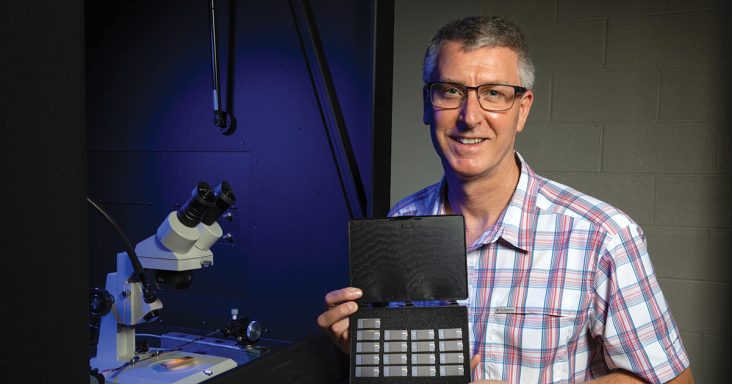Researchers show proof of theory to harness clean energy
by November 9, 2020 1:59 pm 1,888 views

10237_Paul_Thibido-Physics research_lab
A team of University of Arkansas researchers, led by physics professor Paul Thibado, is developing a chip to generate and store energy as a battery replacement.
The team has designed a circuit that’s capable of capturing graphene’s thermal motion and converting it into an electrical current.
As a two-dimensional material, graphene is a single layer of carbon atoms and comprises the individual layers of carbon in graphite, according to Encyclopedia Britannica. Like diamond and graphite, graphene is a carbon allotrope, meaning they all have the same atoms but are arranged differently, and this gives them different properties, according to Digital Trends. Physicists Konstantin Novoselov and Andre Geim successfully isolated graphene into a single-layer form in 2004.
“An energy-harvesting circuit on graphene could be incorporated into a chip to provide clean, limitless, low-voltage power for small devices or sensors,” Thibado said.
The researchers’ findings, “Fluctuation-induced current from freestanding graphene,” were recently published in journal “Physical Review E” as proof of a theory the team developed at the UA three years ago that freestanding graphene ripples and buckles in a way that could be harvested for energy, a news release shows. The team determined that at room temperature the thermal motion of graphene produces an alternating current (AC) in a circuit.
The team designed the circuit using two diodes for converting AC into direct current (DC). The diodes, which act as electrical current gateways, were set in opposition to allow the current to flow both ways and provided separate paths through the circuit, producing a pulsing DC current that performs work on a load resistor.
“We also found that the on-off, switch-like behavior of the diodes actually amplifies the power delivered, rather than reducing it, as previously thought,” Thibado said. “The rate of change in resistance provided by the diodes adds an extra factor to the power.”
Pradeep Kumar, associate professor of physics and research co-author, said the graphene and circuit have a symbiotic relationship and maintain the same temperature.
“People may think that current flowing in a resistor causes it to heat up, but the Brownian current does not,” Thibado explained. “In fact, if no current was flowing, the resistor would cool down. What we did was reroute the current in the circuit and transform it into something useful.”
Brownian motion regards the thermal motion of atoms. Physicist Richard Feynman asserted the thermal motion of atoms, or Brownian motion, cannot perform work. However, the UA researchers found they could harvest energy from the thermal motion of graphene.
Their next objective is to determine if DC current can be stored in a capacitor for later use. This requires reducing the size of the circuit and placing it on a silicon wafer or chip. If millions of the tiny circuits could be built on a 1-millimeter by 1-millimeter chip, they could serve as a low-power battery replacement. Thibado said the team has worked through multiple design cycles of the chip and hopes to have it completed in a year.
Other researchers include physics professor Surendra Singh, associate physics professor Hugh Churchill and Jeff Dix, assistant professor of engineering. The research has received funding from the Chancellor’s Commercialization Fund, supported by the Walton Family Charitable Support Foundation.
